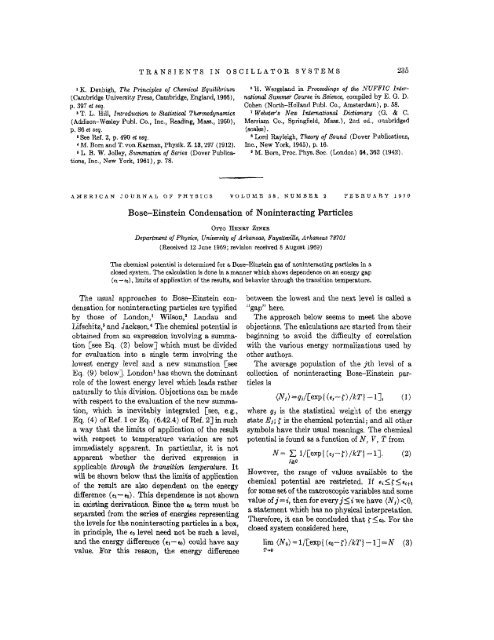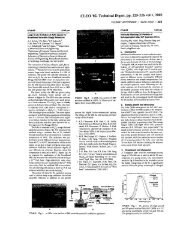THE PHYSICS OF FLUIDS VOLUME 14, NUMBER I JANUARY 1971Snowplowing in a Plasma Rail GunD. W. COLLIEB* AND 0. a. ZINKEDeparfmenl <strong>of</strong> Physicb, Un6era <strong>of</strong> Arkanm, Pay~lls,Arkamas 78701(Reoeiied 4 September 1988; final manuscript rewived 4 Msy 1970)Agreement between data from a plarmra rail yn aa analysed by a time<strong>of</strong>-flight technique andpredicted by ~wplow theory indimtea that there is no necessity for any theory <strong>of</strong> drag force in thegun end seema to indiarte that om theory for drag force which also accounta for the conduotion <strong>of</strong>electrical current into a moving plasma ahould be re-eanmined.INTRODUCTIONOne poasible technique for studying the mannerin which electric current is conducted into a plasmfrom conducting walls is to determine the behavior<strong>of</strong> the plasma aa it moves with respect to the wallsin a device such as a plasma gun. It has been notedby Thom, Norwood, and Jalufka' that movingplasmas never achieve expected flow velocities insuch devices. In the same article it has been postulatedthat a moving plasma may be slowed if theconduction <strong>of</strong> electric current into the plasma fromthe walh occurs through the positive ions <strong>of</strong> theplssma. The efiect has been celled drag force.'Lovberga has <strong>of</strong>fered a postulate which depends on"whether the current front in the gun acts as atight piston or whether it displays permeability."Apparently technical literature by Lovberg,Gooding, and, Haywortha as quoted by Thom,Norwood, and Jaluflca' attribute the di5culty tothe "maseloading problem" which, according, tothe latter authors, "describes the technical problem<strong>of</strong> matching the inertia <strong>of</strong> the mass <strong>of</strong> the plasmato the inertia <strong>of</strong> the electrical circuitry whichpowers the gun."hae been described in some detail by Msnka4 andRoss' and used by Manka, Crawford, and <strong>Zinke</strong>'and Rosa and <strong>Zinke</strong>.' The technique yielde thetemperature (2') <strong>of</strong> the positive ions <strong>of</strong> the plaema,the flow velocity (V) <strong>of</strong> the plasma as it exit, therails, the ion population <strong>of</strong> the plaama (N), andthe time the plasma is relessed from the rails.Manka4 estimates that oscilloscope reading mrs,the principal source <strong>of</strong> error, give a 50% variationin the measured temwature and a 15% variationin the memured flow velocity. Reading errors maycause pbma releaee times to be <strong>of</strong>f 6 these databy as much as several microseconds. For similarreasons the ion population may be <strong>of</strong>f by a factor<strong>of</strong> 2 and is, additionally, subject to the assumption<strong>of</strong> a fully 'ionized plasma being present. Snowplowtheory ie modified here to predict, in addition tothe flow velocity <strong>of</strong> the plasma, the temperature,the ion population, and the plasma release time.SNOWPLOW THEORYThe theory will assume that a plasma <strong>of</strong> initialpositive ion population n~ originates at one end<strong>of</strong> a rail gun and ie accelerated to the other throughIn any event, the energy lost to drag force is a neutral gas <strong>of</strong> n, atoms or .moIeculee per unitexperimentally <strong>of</strong> the same order <strong>of</strong> magnitude <strong>of</strong> length. The point <strong>of</strong> plasma initiation will be takenthe flow energy and the various theories would as z = 0. The plasma is sssumed created in aapparently have to predict loaaea <strong>of</strong> lie order <strong>of</strong> breakdown <strong>of</strong> neutral-gas caused by the dischargemagnitude. It is the purpose here to report that <strong>of</strong> an energy storage capacitor. The plasma fomif plasma drag occurs with a simple rail gun, the one component <strong>of</strong> a simple series circuit. Theenergy transferred to the drag mechanism must mowplow equation derived here will be Bimilar tobe at least an order <strong>of</strong> magnitude less than the that derived by Hart? However, the nobtion <strong>of</strong>plasma flow- energy. Indeed, simple snowplowing Mostev, Neuringer, and Rigneyo will be d.seems to account for dl aspects <strong>of</strong> plasma behavior Kirch<strong>of</strong>fla law for a plasm8 driven by a diechargingobserved. Therefore, the variom theories for plasma capwitor is [see, e.g., Eq. (1) <strong>of</strong> Ref. 91drag should be re-examined and, in particular, thetheory <strong>of</strong> Thom, Notwood, and JaLufks1 which d(LOz +accounts for the flow <strong>of</strong> electric current into thedl+ (go + Rr + RJIplasma should be, reviewed. + e/1 ' Zdl = Vo. (I):Measurements <strong>of</strong> plssma characteristics weremade through the time-<strong>of</strong>-fight technique which The inductance L, ia ~ssociated with the oircuit i72
TRANSIENTS IN OSCILLATOR SYSTEMS 2351 K. Denbigh, The Principles <strong>of</strong> Chemical Equilibrium(Cambridge U~~iversity Press, Cambridge, England, 1968),p. 397 et seq.ST. L. Hill, Introduction to Stalistieal ThRllnodynamics(Addison-IVesley Publ. Co., Inc., &ding, Mm., 19GO),p. 86 et seq.8 See Ref. 2, p. 490 et seq.W. Born and T. von Karman, Physik. Z. 13,297 (1912).6 L. B. W, Jolley, Summation <strong>of</strong> Series (Dover Fublications,Inc., New York, 1961), p. 78.OH. Wergeland in Proceedings <strong>of</strong> the nTUFFIC InternationalSumm Course in Science, compiled by E. G. D.Cohen (North-Holland Publ. Co., Amsterdam), p. 58.Webster's New I&rnationaE Dictioaary (G. & C.hlerriam Co., Springfield, Mass.), 2nd ed., unabridged(scnles) .Lord lbyleigh, Theory <strong>of</strong> Sound (Dover Publications,Inc., New York, 1945), p. 16.M. Born, Proc. Phys. Soc. (London) 64,382 (1942).ANERICAN JOURNAL OF PHYSICS VOLUME 38. PiTjMBER 2 FEBRU.4RY 1970Bose-Einstein Condensation <strong>of</strong> Noninteracting ParticlesOTTO HENRY ZINEE<strong>Department</strong> <strong>of</strong> <strong>Physics</strong>, <strong>University</strong> <strong>of</strong> <strong>Arkansas</strong>, Fayetteuille, <strong>Arkansas</strong> 797'01(Received 12 June 1969; revision received 8 August 1969)Tlie cbemical potential is determined for a, Bose-Eiwtein gas <strong>of</strong> noninteracting particles in aclosed system. The calculation is done in a manner which shows dependence on an energy gap(a-a), limits <strong>of</strong> application <strong>of</strong> the results, and behavior through the transition temperature.The usual approaches to Bose-Einstein condensationfor noninteracting particles are typifiedby those <strong>of</strong> London,' Wilson,= Landau andLifschit~,~ &nd Jackson.4 The chemical potential isobtained from an expression involving a summation[see Eq. (2) below] which must be dividedfor evaluation into a single term involving thelowest energy level and a new summation [seeEq. (9) below]. London' has shown the dominantrole <strong>of</strong> the lowest energy level which leads rathernaturally to this divhion. Objections can be madewith respect t.o the evaluation <strong>of</strong> the new summation,which is inevitably integrated [see, e.g.,Eq. (4) <strong>of</strong> Ref. 1 or Eq. (6.42.4) <strong>of</strong> Ref. 21 in sucha way that the limits <strong>of</strong> application <strong>of</strong> the resultwith respect to temperature variation are notimmdately apparent. In particular, it is notapparent whether the derived expression isapplicable through the transition ternperdure. Itwill be shown below that the limits <strong>of</strong> application<strong>of</strong> the result are also dependent on the energydifference (a-Q). This dependence is not shownin existing derivations. Since the s term must beseparated from the series <strong>of</strong> energies representingthe levels for the noninteracting particles in a box,in principle, the eo level need not be such a level,and the energy difference (el- a) could have anyvalue. For this reason, the energy differencebetween the lowest and the next level is called a"gap" here.The approach below seems to meet the aboveob,jections. The calculations are started from theirbeginning to avoid the difficulty <strong>of</strong> correlationwith the various energy normalizations used byother authors.The average population <strong>of</strong> the jth level <strong>of</strong> acollection <strong>of</strong> noninteracting Bose-Einstein particlesisvhere gj is the statistical weight <strong>of</strong> the energystate Ej; r is the chemical potential; and all othersymbols have their usual meanings. The chemicalpotential is found as a function <strong>of</strong> N, V, T fromN= l/[exp( (ej-{)/kT] -1.1. (2)j20However, the range <strong>of</strong> values available to thechemical potential are restricted. If ei 5 T < ei+lfor some set <strong>of</strong> the macroscopic variables and somevalue <strong>of</strong> j=i, then for every jsi we have (Nj)













